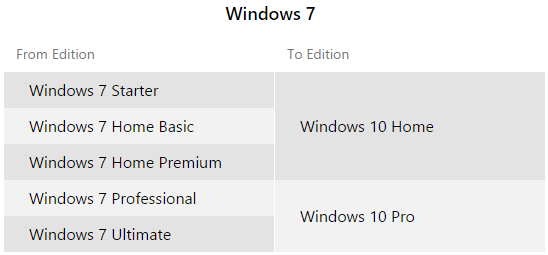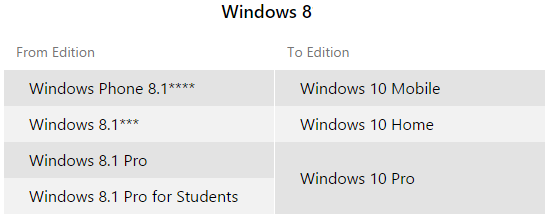This weekend was a big hurricane of Windows 10 news. First, OEM pricing leaked for the operating system. Then, Microsoft started prompting Windows 7 SP1 and Windows 8.1 users to “reserve” their free Windows 10 upgrade. Finally, we learned Windows 10 for PCs will launch on July 29, 2015.
Update on July 29: It’s here! Read our review.
But there’s more. A lot of details have been added to four Windows 10 support pages: features, upgrade, FAQ, and specifications. Let’s run through what you need to know if you’re upgrading your Windows PC to the latest version (Windows 10 for phones is coming later — we don’t know the launch date or exact upgrade details, but we’ll update you when we do).
First and foremost, while the hardware requirements and upgrade paths for PC makers were first posted in March, Microsoft has now made them official. Here is what you need to get the Windows 10 for PCs upgrade:
- Processor: 1GHz or faster processor or SoC
- RAM: 1GB for 32-bit, 2GB for 64-bit
- Hard disk space: 16GB for 32-bit OS, 20GB for 64-bit OS
- Graphics card: DirectX 9 or later with WDDM 1.0 driver
- Display: 1024×600 resolution
Hardware aside, Windows 10 upgrades require Windows 7 SP1 or Windows 8.1. That means if you have Windows 7 or Windows 8, you’ll have to run Windows Update a few times before you can upgrade to Windows 10.
Other upgradeability factors include driver and firmware support, application compatibility, and feature support. To make sure your PC with Windows 7 SP1 or Windows 8.1 can run Windows 10, you can use the Get Windows 10 app.
https://www.youtube.com/watch?v=Mnc48BVZqrs
If you have Windows Vista, Windows XP, or anything older, you’ll have to buy Windows 10 and install it from scratch. That said, if you still have a computer running such an old operating system, it’s probably time to get a new computer anyway.
Windows 10 Home will cost $119, Windows 10 Pro will go for $199, and a Windows 10 Pro Pack (which lets you upgrade from Windows 10 Home to Windows 10 Pro) will set you back $99. If that seems steep to you, you should know that for one year, Microsoft is offering free upgrades for Windows 7 SP1 and Windows 8.1 users.
“The easiest way to get Windows 10 is to upgrade for free,” a Microsoft spokesperson told VentureBeat. “You may also purchase a copy of Windows 10 if you decide not to upgrade, or if you need to purchase a copy for other reasons like installing on a PC you built yourself. The suggested retail prices for Windows 10 in the U.S. are the same as Windows 8.1. Windows 10 Home is an estimated retail price of $119. Windows 10 Pro is an estimated retail price of $199. And Windows 10 Pro Pack, which enables you to upgrade from Windows 10 Home to Windows 10 Pro, is an estimated retail price of $99. All these are available in stores or online.”
Because the launch date is now revealed, Microsoft also confirmed that users only have until July 29, 2016 to take advantage of the free upgrade offer. Once the upgrade is complete, Windows 10 will be free forever on that device.
Here are the upgrade paths Windows 7 SP1 users can expect:
Here are the upgrade paths Windows 8.1 users can expect:
Notice that that the upgrade offer is only for consumers. There are seven Windows 10 editions in total, but the Windows 10 offer is only for three.
Applications, files, and settings will migrate as part of the upgrade. Microsoft does warn, however, that some applications or settings “may not migrate,” so make sure to back up anything you can’t afford to lose.
https://www.youtube.com/watch?t=17&v=NDwL5qSCkqU
The “reserve” news this weekend is part of the free upgrade offer — reservation makes it easier to upgrade, but it’s not required. To start the process, click on the small Start button icon in the system tray on your taskbar.
Here is how it looks:
This will launch the Get Windows 10 app. If you don’t see this notification, you can learn more about forcing it and other details in our detailed writeup. Click “Reserve your free upgrade” in the app window and enter your email if you want a confirmation.
Microsoft says that between reservation and when the upgrade is ready, files your computer needs for the upgrade will be downloaded to your PC to speed up the final installation. The Windows 10 upgrade will become available sometime after July 29, 2015, and a notification will let you know you can start the process. While some notifications will go out as soon as Windows 10 is available, Microsoft says others “may go out in the weeks or months following.”
You can get a free upgrade for each Windows computer that meets the requirement. The actual installation will take anywhere from 20 minutes to more than an hour, depending on your computer.
Since the launch is almost here, Microsoft is continuing to communicate new Windows 10 features. Most recently, the company released this video:
https://www.youtube.com/watch?v=Wwc5jKc-EgE
Yet Microsoft today also revealed what Windows users lose if they upgrade:
- If you have Windows 7 Home Premium, Windows 7 Professional, Windows 7 Ultimate, Windows 8 Pro with Media Center, or Windows 8.1 Pro with Media Center and you install Windows 10, Windows Media Center will be removed.
- Watching DVDs requires separate playback software (Microsoft has said before that a future update will add this functionality back “later this year”).
- Windows 7 desktop gadgets will be removed as part of installing Windows 10.
- Windows 10 Home users will have updates from Windows Update automatically available. Windows 10 Pro and Windows 10 Enterprise users will have the ability to defer updates.
- Solitaire, Minesweeper, and Hearts Games that come preinstalled on Windows 7 will be removed as part of installing the Windows 10 upgrade. That said, new versions Microsoft Solitaire Collection and Microsoft Minesweeper will be installed.
- If you have a USB floppy drive, you will need to download the latest driver from Windows Update or from the manufacturer’s website.
- If you have Windows Live Essentials installed on your system, the OneDrive application is removed and replaced with the inbox version of OneDrive.
In short, most users won’t be missing out on much. The bigger losses will be addressed in the months after Windows 10’s debut.
Last but not least, if you’re wondering about the free Windows 10 upgrades for pirates, that’s not happening. Microsoft clarified all that last month.
VentureBeat's mission is to be a digital town square for technical decision-makers to gain knowledge about transformative enterprise technology and transact. Learn More




